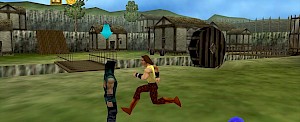Preview: Castlevania Dawn of Sorrow
Posted 28 Feb 2005 at 07:03 by Conor
Message boarders and game columnists alike like to complain about sequels; about how they decimate the idea of originality and eventually become cash whores for the risk avoiding publishers. Konami's Castlevania series, though, has been soldering on since the NES and went through around twenty editions, depending on what you do or don't view as 'proper' Castlevania games and now the DS version looks to keep up the strength of the franchise. So they're not so evil, it appears.
“Third pillar” or not, the DS is the spiritual successor to the Game Boy, and will be picking up the GBA's Castlevania thread. Three games of the series graced Nintendo's handheld; the first two with mixed results, but the third, Aria of Sorrow was somewhat a winner. The game concerned itself with our hero, Soma Cruz, and his plight inside the castle of Dracula himself. By the end of the game Soma was a changed man, his mystical heritage and powers revealed. Castlevania DS (expect a subtitle soon) follows on from AoS, picking up a year after the game's events. Soma is trying to put what happened to him behind him and live a normal life, but, as is ever the case with gaming protagonists, his past just won't leave him be. A strange cult attacks him, believing that his sacrifice will bring about the rise of a new dark lord.
CDS' heritage is evident in more than its plot. The change of style introduced by the Playstation's classic Symphony of the Night continued with the GBA's titles, and that style remains unchanged for the DS. Less RPG-based than earlier entries in the series, they take a Metroid-esque action/adventure slant, complete with combat and movement upgrades. Aria of Sorrow also introduced a 'soul system', whereby new abilities were obtained from the souls of vanquished enemies; an upgrade system that Castlevania DS keeps.
Heritage aside, this is a DS game, and what has the DS brought to the series? Giving the traditionalism of the genre and of the Castlevania franchise, we were never expecting a touch-based overhaul of the series, but there have been some changes. The touch screen will be used in a few different instances; for example you can use it to carve out agreeable routes through diamond blocks, although it's hard to see this being much more than a minor distraction. The dual screens allow the map to be displayed on the top screen, while all the action takes place under it. Nothing fancy, but it does de-clutter the main screen. Also, wireless connectivity means items can be transferred between players, but this is where use of the DS' functions ends.


Open wide. The Graphics are highly improved from the GBA.
What really makes the DS treatment of the series stand out from its GBA parents are the visual upgrades. The GBA is a great little machine, but there's no denying that its capacity for atmospheric visuals is rather limited. The DS' superior hardware allows the Castlevania series to somewhat return to the poetic beauty of Symphony of the Night: detailed character sprites, scrolling backgrounds, moody lighting. Even the audio has reportedly been bumped up a notch.
Although it's a move forward for the series, Castlevania DS' best attributes are its steps back towards the greatness of Symphony of the Night. If Konami get themselves a snazzy subtitle, they'll probably be onto a winner. We'll keep you posted anyway.
























